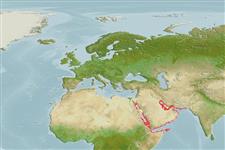>
Eupercaria/misc (Various families in series Eupercaria) >
Sparidae (Porgies)
Etymology: Acanthopagrus: Greek, akantha = thorn + Greek, pagros, a kind of fish (Ref. 45335).
More on author: Forsskål.
Environment: milieu / climate zone / depth range / distribution range
ນິເວດວິທະຍາ
ສັດທະເລ; ນ້ຳກ່ອຍ ກ່ຽວກັນຫີນ; ລະດັບຄວາມເລິກ 2 - 20 m (Ref. 9710). Tropical; 32°N - 10°N, 33°E - 65°E (Ref. 95256)
Western Indian Ocean: Red Sea (Israel, Egypt, Eritrea, Saudi Arabia), Persian Gulf (Bahrain and Kuwait), off southern Oman (not Gulf of Oman); presumably along the whole southern coast of the Arabian Peninsula, also Iran to Pakistan.
Length at first maturity / ຂະໜາດ / ນ້ຳໜັກ / Age
Maturity: Lm 26.4 range ? - ? cm
Max length : 36.2 cm SL ຕົວຜູ້/ບໍ່ມີເພດ; (Ref. 95256); common length : 40.0 cm TL ຕົວຜູ້/ບໍ່ມີເພດ; (Ref. 5450); ອາຍຸສູງສຸດທີ່ເຄຍລາຍງານມາ: 19 ປີ (Ref. 3625)
ຄີ (ໜາມ)ແຂງຢູ່ຫຼັງປາ (ທັງໝົດ): 11; ຄີຫຼັງຂອງປາ (ຄີອ່ອນ) (ທັງໝົດ): 12-15; ຄີ(ໜາມ) ແຂງຢູ່ຄີກົ້ນປາ
ກຸ່ມປາກະດູກແຂງ
ຄວາມຖີ່ຂອງກຸ່ມຖ່າຍທອດພັນ
ປາທີ່ມີການເຄື່ອນຍ້າຍຈາກທະເລໄປຫານ້ຳຈືດ ແລະນ້ຳຈືດຫາທະເລ
ປາທີ່ມີການເຄື່ອນຍ້າຍຈາກທະເລແລະໄປໄຂ່ຢູ່ນ້ຳຈືດ
ຄີກົ້ນຂອງປາ
ສັດທີ່ມີກະດູກສັນຫັຼງ
ການຖ່າຍທອດທາງກຳມະພັນຈາກພໍ່ແມ່ຫາລູກ 3; ຄີກົ້ນຂອງປາ: 10 - 11. This species is distinguished from its congeners by the following set of characters: 2 conspicuous vertical black bars across the head, with the first bar from occiput through eye and across cheek to rear end of maxilla. while the second bar is from nape to opercle; colour of dorsal and caudal fins yellow, without dense black margin of dorsal-fin or narrow black edge along rear margin of caudal fin; scale rows from 5th dorsal fin spine to lateral line 5 ½ or 6 ½ ; base of dorsal and anal fins are scaly; naked interorbital area and preopercle flange; along each side of upper jaw with 2 rows of molars, with the outer molar teeth row extending to rear end of both jaws; basal width of incisor teeth (usually 6) at front of upper jaw smaller, 0.7?0.8 mm for 15 cm SL fish and 2.2?2.5 mm for fish of 34 cm SL, respectively; D XI,12?15, no elongated spines; A III,10?11, with the 2nd and 3rd anal-fin spines subequal and not enlarged (Ref. 95256).
Occur in small groups. (Ref. 9710). Marketed fresh or dried.
Iwatsuki, Y. and P.C. Heemstra, 2011. A review of the Acanthopagrus bifasciatus species complex (Pisces: Sparidae) from the Indian Ocean, with redescription of A. bifasciatus (Forsskål 1775) and A. catenula (Lacepède 1801). Zootaxa 3025:38-50. (Ref. 95256)
IUCN Red List Status (Ref. 130435)
Threat to humans
Harmless
Human uses
ການປະມົງ: ທີ່ເປັນການຄ້າໜ້ອຍ
ຂໍ້ມູນຕື່ມອີກ
ເອກະສານອ້າງອີງການລ້ຽງສັດນ້ຳຂໍ້ມູນການລ້ຽງສັດນ້ຳສາຍພັນກຳມະພັນElectrophoresesການຖ່າຍທອດທາງກຳມະພັນຈາກພໍ່ແມ່ຫາລູກພະຍາດການປຸງແຕ່ງNutrientsMass conversion
ຜູ້ຮ່ວມມືຮູບStamps, Coins Misc.ສຽງຫອຍມີພິດຊະນິດນຶ່ງທີ່ອາໄສໃນທະເລຄວາມໄວປະເພດການລອຍເນື້ອທີ່ເຫືອກOtolithsສະໝອງວິໄສທັດ
ເຄື່ອງມື
Special reports
Download XML
ແຫຼ່ງອີນເຕີເນັດ
Estimates based on models
Preferred temperature (Ref.
123201): 25 - 29.2, mean 27.6 °C (based on 323 cells).
Phylogenetic diversity index (Ref.
82804): PD
50 = 0.5000 [Uniqueness, from 0.5 = low to 2.0 = high].
Bayesian length-weight: a=0.01549 (0.00977 - 0.02454), b=3.03 (2.90 - 3.16), in cm total length, based on LWR estimates for this species & (Sub)family-body (Ref.
93245).
ຊັ້ນເຂດຮ້ອນ (Ref.
69278): 3.4 ±0.43 se; based on food items.
ຄວາມຢືດຢຸ່ນ (Ref.
120179): ຂະໜາດກາງ, ປະຊາກອນຕຳ່ສຸດທີ່ໃຊ້ເວລາສອງເທົ່າ 1.4 - 4.4 ປີ (K=0.18; tmax=19).
Fishing Vulnerability (Ref.
59153): Moderate vulnerability (37 of 100).
Climate Vulnerability (Ref.
125649): High to very high vulnerability (67 of 100).
Nutrients (Ref.
124155): Calcium = 57.6 [28.0, 94.1] mg/100g; Iron = 0.603 [0.332, 1.093] mg/100g; Protein = 19.9 [18.7, 21.2] %; Omega3 = 0.149 [0.097, 0.240] g/100g; Selenium = 22.9 [12.0, 42.3] μg/100g; VitaminA = 81.8 [22.8, 247.2] μg/100g; Zinc = 1.48 [1.01, 2.10] mg/100g (wet weight);
